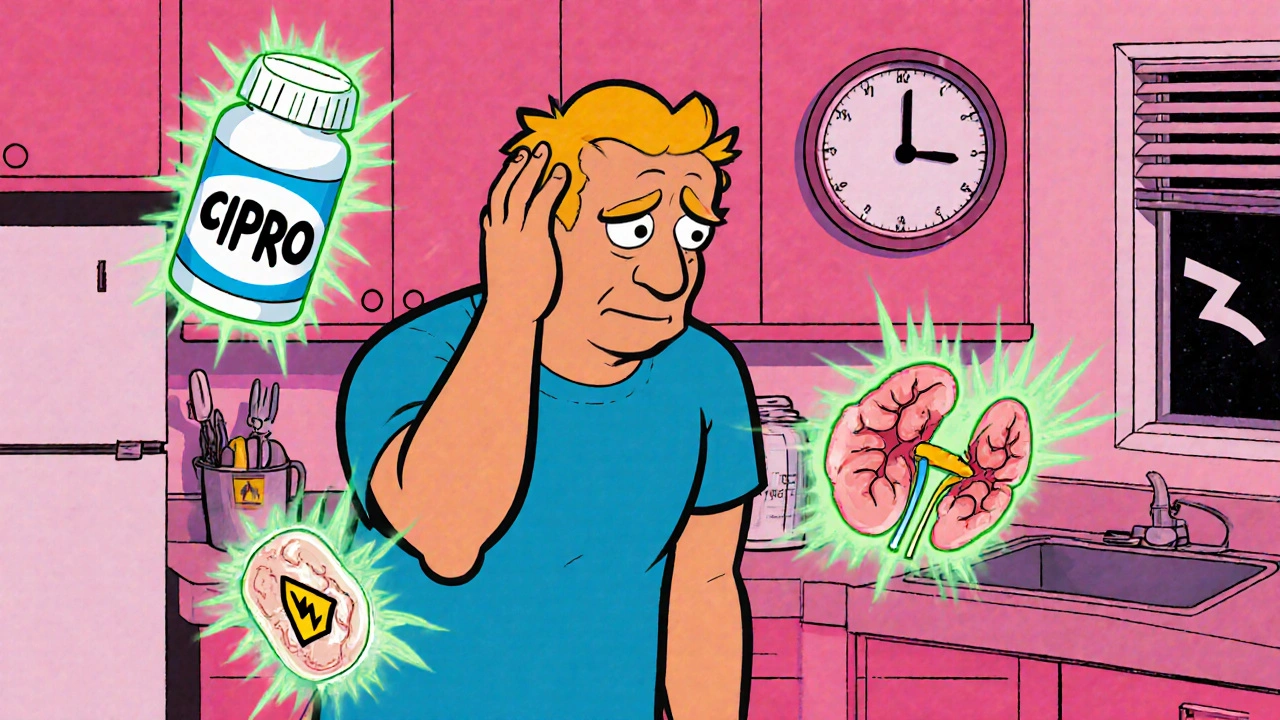Fluoroquinolone Antibiotics and NSAIDs: Why Combining Them Raises Serious Neurologic and Kidney Risks

Fluoroquinolone and NSAID Risk Estimator
Personal Risk Assessment
This tool calculates your risk of kidney and neurological damage when taking fluoroquinolone antibiotics (like ciprofloxacin or levofloxacin) with NSAIDs (like ibuprofen or naproxen). Based on the latest medical research, combining these drugs significantly increases risk, especially for those over 60, with kidney issues, or dehydration.
When you’re sick with a urinary tract infection or sinusitis, your doctor might reach for a fluoroquinolone antibiotic like ciprofloxacin or levofloxacin. At the same time, you might reach for ibuprofen or naproxen to ease the fever or joint pain. It seems logical-two common medications, two common problems. But what if combining them could trigger something far more dangerous than you ever expected? The truth is, this everyday combo can seriously harm your kidneys and your brain-even if you’re otherwise healthy.
What Are Fluoroquinolones, Really?
Fluoroquinolones are a class of antibiotics that include ciprofloxacin, levofloxacin, moxifloxacin, and ofloxacin. They’ve been used for decades to treat stubborn infections like pneumonia, UTIs, and even anthrax. But they’re not like regular antibiotics. They work differently, and they carry a unique set of risks that most people don’t know about.
These drugs don’t just kill bacteria-they can mess with your body’s own cells. In 2017, Health Canada issued a major safety alert after reviewing hundreds of reports of patients who developed lasting nerve damage, tendon ruptures, and brain fog after taking fluoroquinolones. The agency said these side effects could be persistent and disabling, even after stopping the drug. The European Medicines Agency confirmed this, finding 286 cases of severe, long-lasting harm across 21 years in Europe-even though over 300 million doses are given out every year.
And it’s not just a few rare cases. Patient groups like the Fluoroquinolone Effects Research Foundation surveyed over 1,200 people. Nearly 80% said their symptoms lasted more than six months. Over a third reported permanent disability-chronic pain, nerve damage, or brain fog that never went away.
How Fluoroquinolones Hurt Your Kidneys
Your kidneys filter your blood. They’re sensitive. Fluoroquinolones can cause a type of kidney injury called acute interstitial nephritis. That’s when immune cells invade the kidney tissue and cause swelling. In some cases, the drug forms crystals in your urine, especially if you’re dehydrated or your urine is too alkaline. This can block tiny tubes in the kidney and lead to acute tubular necrosis-where kidney cells die off.
A 2013 study published in PMC3708027 found that men taking fluoroquinolones had twice the risk of being hospitalized for acute kidney injury compared to those not taking them. The risk goes up even more if you’re over 60, have high blood pressure, or already have reduced kidney function. Your kidneys naturally slow down with age-by about 1% per year after 40. That means older adults are sitting ducks for this kind of damage.
NSAIDs and Kidneys: A Silent Threat
NSAIDs-like ibuprofen, naproxen, and diclofenac-are everywhere. You buy them over the counter. You take them for headaches, back pain, or menstrual cramps. But they’re not harmless. These drugs block prostaglandins, chemicals your body uses to keep blood flowing to your kidneys. Without enough blood flow, your kidneys can’t filter waste properly.
This is especially dangerous if you’re dehydrated, have heart failure, or are already on blood pressure meds. But here’s the kicker: when you combine NSAIDs with fluoroquinolones, the risk doesn’t just add up-it multiplies. A 2013 study in JAMA Internal Medicine found that elderly patients taking both drugs had a 3.5-fold higher risk of acute kidney injury than those taking either one alone.
One real case from the UK’s Yellow Card system tells the story: a 58-year-old man took ciprofloxacin and ibuprofen for a UTI. His creatinine level-how we measure kidney function-jumped from 82 to 287 μmol/L in just a few days. That’s a severe drop in kidney performance. His nerve damage and kidney issues didn’t improve even 18 months later.

Neurological Damage: When Your Brain Turns Against You
Fluoroquinolones don’t just target bacteria-they can cross the blood-brain barrier. Once inside, they interfere with GABA receptors (which calm your brain) and overstimulate NMDA receptors (which excite your brain). The result? Seizures, confusion, hallucinations, delirium, and even psychosis.
Levofloxacin is especially linked to seizures and mental confusion. Ciprofloxacin causes dizziness and brain fog. Even people with no history of mental illness can experience these effects. The risk skyrockets if your kidneys aren’t clearing the drug properly. In moderate kidney impairment (eGFR 30-59), fluoroquinolone levels in your blood can rise by 50-100%. That’s like taking double the dose without realizing it.
NSAIDs aren’t innocent here either. While they rarely cause serious brain issues, they can trigger headaches, dizziness, and-very rarely-aseptic meningitis. That’s when the lining around your brain swells without infection. It’s uncommon, but it happens more often with ibuprofen and naproxen.
Together, these drugs create a perfect storm. Your kidneys slow down. The fluoroquinolone builds up. Your brain gets flooded with a neurotoxic mix. The outcome? A patient who can’t think clearly, can’t walk steadily, and may never fully recover.
Who’s Most at Risk?
This isn’t a risk for everyone-but it’s not rare either. Certain groups should avoid this combo entirely:
- People over 60
- Anyone with chronic kidney disease (eGFR below 60)
- Those with epilepsy, Parkinson’s, or other neurological conditions
- Patients taking corticosteroids (which also raise tendon and nerve damage risk)
- People with a history of tendon rupture or peripheral neuropathy
Even if you’re young and healthy, if you’re dehydrated, exercising intensely, or taking other medications that affect kidney function, you’re still vulnerable. These drugs don’t care how fit you are-they care about how your body processes them.

What Should You Do Instead?
If you need an antibiotic and you’re also in pain, you have better options.
For UTIs: Nitrofurantoin or fosfomycin are safer than fluoroquinolones. They’re just as effective for simple infections and don’t carry the same neurological or kidney risks.
For respiratory infections: Amoxicillin-clavulanate or doxycycline are good alternatives. They’re broad-spectrum but much gentler on your body.
For pain: Skip NSAIDs. Use acetaminophen (paracetamol) instead. It doesn’t hurt your kidneys or interfere with antibiotics. It’s not as strong for inflammation, but it’s far safer when you’re on fluoroquinolones.
And if your doctor pushes a fluoroquinolone? Ask: "Is this the only option?" The FDA, Health Canada, and the EMA all now say these drugs should be reserved for infections with no other treatment options. That means if you have a simple UTI or sinus infection, you probably don’t need one.
The Bigger Picture: Why This Is Still Happening
Despite all the warnings, fluoroquinolones are still prescribed over 20 million times a year in the U.S. That’s down from 28 million in 2015, but still too high. In countries like India and China, they’re used even more heavily-often without proper testing or oversight.
Why? Because they’re cheap, effective, and fast-acting. Doctors reach for them out of habit. Patients expect them. But the long-term cost is staggering. A 2020 study estimated fluoroquinolone-related side effects cost the U.S. healthcare system $1.8 billion annually. Nearly 40% of that was due to kidney injury. Another 30% came from neurological damage.
And the damage isn’t always visible on a lab report. Many patients report chronic fatigue, brain fog, and muscle pain that doctors dismiss as "psychosomatic." But patient forums like Reddit’s r/FQAntibioticDamage-home to over 14,500 members-show this is real, widespread, and deeply misunderstood.
Bottom Line: Don’t Take the Risk
Fluoroquinolones and NSAIDs aren’t just two pills you take together. They’re two triggers that can set off a chain reaction in your body-one that may never fully reverse. Your kidneys and your brain are too important to gamble with.
If you’re prescribed a fluoroquinolone, ask these three questions:
- Is this the only antibiotic that will work?
- Can I use acetaminophen instead of ibuprofen or naproxen?
- What signs should I watch for-if my urine changes, my legs feel weak, or my head feels foggy-should I stop this?
Don’t assume your doctor knows all the risks. Many don’t. The data is out there. The warnings are real. And the consequences can last longer than the infection ever did.